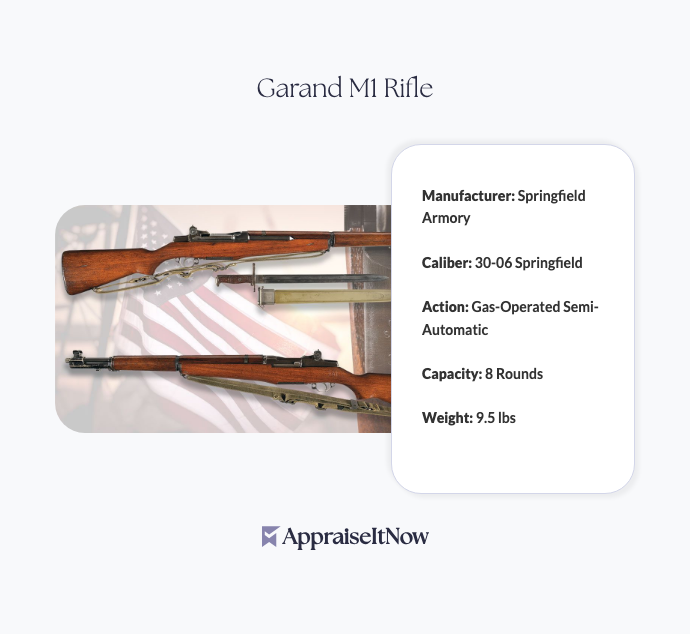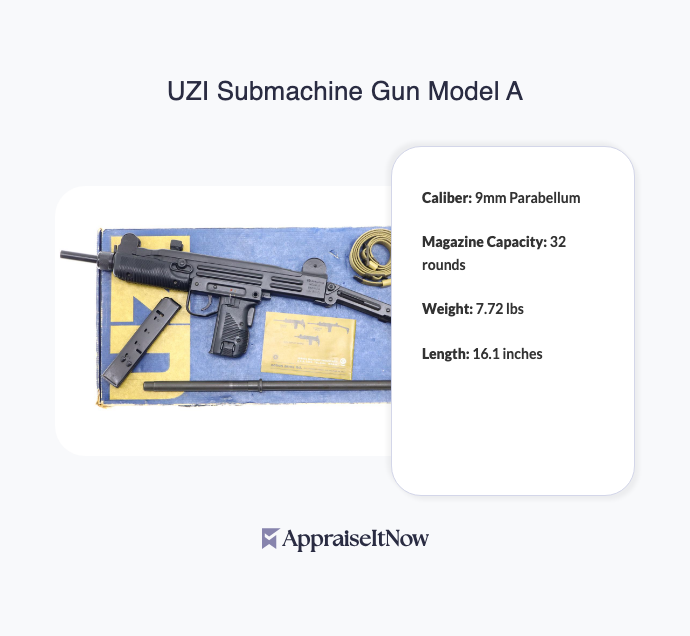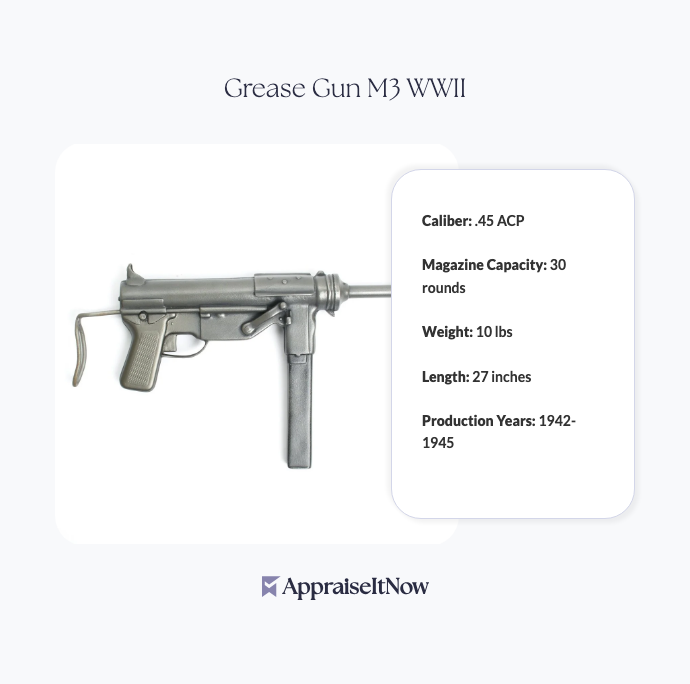<h1>How to Get Your Garand M1 Rifle Appraised</h1>
<p>The Garand M1 Rifle stands as one of America's most iconic military weapons, with current market values ranging from <strong>$800 to $1,800</strong> depending on condition, provenance, and historical significance. Whether you've inherited one, discovered it at an estate sale, or are considering a purchase, understanding how to properly appraise this legendary rifle ensures you make informed decisions backed by professional expertise.</p>
<h2>Understanding Garand M1 Rifle Value Factors</h2>
<p>Your M1's worth depends on multiple interconnected factors that professional appraisers evaluate systematically. Designed by <strong>John Garand</strong> and first introduced in 1936, over <strong>5 million M1 Garands</strong> were produced during World War II and the Korean War, making them more accessible than some collectibles while still commanding significant value due to their historical importance and mechanical excellence.</p>
<p>The rifle's reputation for reliability and accuracy gave American troops a distinct battlefield advantage, and this proven performance translates directly into collector demand today. When asking "<em>How much is a WWII rifle worth today?</em>", the answer varies considerably based on the specific rifle's condition, matching serial numbers, and documented service history. Unlike mass-produced firearms with inflated asking prices, the Garand M1's value reflects its genuine historical significance and practical performance record.</p>
<h2>Condition and Originality Matter Most</h2>
<p>A Garand M1's condition grade dramatically affects its appraisal value. Professional appraisers examine the barrel's internal rifling brightness, original finish integrity, matching serial numbers across all major components, and mechanical function. A rifle in excellent condition with all matching numbers and original parkerized finish can command $1,500–$1,800, while examples showing heavy wear, refinishing, or mismatched components might appraise at $800–$1,000.</p>
<p>The original <strong>en-bloc clip loading system</strong> is a distinctive feature that appraisers verify, as reproduction or damaged feeding systems significantly reduce value. Additionally, rifles marked with specific unit designations or documented combat service typically command 15-25% premiums over unmarked examples. When evaluating why "<em>M1 Garands are so expensive now</em>", much of the appreciation stems from dwindling supplies of quality examples combined with growing collector interest in <a href="/types/memorabilia-and-collectibles">memorabilia and collectibles</a> from this era.</p>
<div class="callout tip"><p><strong>Appraiser's Insight</strong></p>
<p>Matching serial numbers on the receiver, barrel, bolt, and stock indicate an original rifle that hasn't been reassembled from mixed parts—a critical value factor that separates premium examples from field-assembled rifles.</p></div>
<h2>Manufacturing Variations and Production Details</h2>
<p>Production variations significantly influence appraisal outcomes. The M1 Garand underwent multiple manufacturing phases from 1936 through the 1950s, with early production by <strong>Springfield Armory</strong> and later manufacturing by <strong>Winchester</strong> and <strong>Harrington & Richardson</strong>. Each manufacturer's marks affect desirability, with certain producers commanding premium pricing among specialists in <a href="/types/antique-gun">antique guns</a>.</p>
<p>Early 1936-1940 production examples, particularly those from Springfield Armory with correct heat stamps and finishes, typically appraise higher than late-war or post-war manufactured rifles. The <strong>30-06 Springfield</strong> chambering is consistent across all M1 Garands, though international variants exist with different caliber designations that appraisers must distinguish carefully. Understanding these production subtleties requires expertise that distinguishes professional appraisals from casual valuations.</p>
<table class='appraisal-table'>
<thead>
<tr>
<th>Production Period</th>
<th>Manufacturer</th>
<th>Value Premium</th>
<th>Key Characteristics</th>
</tr>
</thead>
<tbody>
<tr>
<td>1936-1940</td>
<td>Springfield Armory</td>
<td>+20-30%</td>
<td>Pre-war correct parts, rare examples</td>
</tr>
<tr>
<td>1941-1945</td>
<td>Springfield/Winchester</td>
<td>Standard</td>
<td>World War II service rifles</td>
</tr>
<tr>
<td>1946-1955</td>
<td>H&R/Springfield</td>
<td>-5-10%</td>
<td>Post-war production</td>
</tr>
</tbody>
</table>
<h2>Authenticity and Documentation Requirements</h2>
<p>Before appraisal, establish your M1's authenticity. Reproductions and parts kits exist in the marketplace, making professional verification essential. Legitimate appraisers examine markings, manufacturing techniques, metallurgy, and finishing methods to confirm genuine WWII-era production. When wondering "<em>Can you legally own an M1 Garand?</em>", the answer depends on your state's regulations—many areas allow civilian ownership while others restrict or prohibit possession, making appraisals crucial for legal compliance verification.</p>
<p>Documentation strengthens your appraisal considerably. If your rifle came with military records, unit documentation, or service history, compile these materials for your appraiser. Even partial provenance—a previous owner's name, service branch, or deployment information—adds context that increases value and collector appeal. Our guide on <a href="/blog/what-to-look-for-when-appraising-an-antique-gun">what to look for when appraising an antique gun</a> provides detailed authentication checklists.</p>
<h2>Why Professional Appraisals Matter</h2>
<p>Attempting to determine value through online price guides often leads to inaccurate estimates. The question "<em>How much does a Springfield M1 Garand cost?</em>" produces wildly varying answers because condition assessments, production verification, and market positioning require specialized expertise. Professional appraisers provide <strong>USPAP-compliant</strong> documentation accepted by insurance companies, auction houses, and financial institutions—essential when managing valuable firearms as estate assets or insurance coverage.</p>
<div class="callout note"><p><strong>Critical Consideration</strong></p>
<p>Insurance companies typically require professional appraisals from credentialed experts before issuing valuable collections coverage, protecting your investment with documentation that stands up to claims assessment.</p></div>
<p>Your appraiser should hold credentials from recognized organizations like <strong>ISA, ASA, AAA, or CAGA</strong>, indicating rigorous training in valuation methodology and ethics. When seeking qualified professionals, AppraiseItNow connects you with certified firearms specialists who understand the nuanced market dynamics affecting Garand M1 valuations, delivering reports suitable for insurance, sale, estate planning, or legal proceedings.</p>
<h2>Current Market Dynamics and Price Trends</h2>
<p>Understanding why "<em>Are M1 Garands rare?</em>" requires context about production versus survivorship. While 5+ million were produced, many were destroyed, lost, or rendered inoperable through government demilitarization. Quality examples in shootable condition have become increasingly scarce, supporting steady price appreciation. The market shows particular strength for rifles with documented combat histories or specific unit markings that connect them to historical events.</p>
<p>The question "<em>What is the 1 in 30 rule for guns?</em>" and "<em>What is the rule of 3 for guns?</em>" often confuses collectors—these refer to different collecting practices rather than universal valuation principles. Professional appraisers focus on established market comparables, recent sales data, and condition-based grading rather than folk wisdom about collecting rules. Current market trends show consistent demand from both shooters seeking historically significant firearms and collectors building <a href="/blog/how-to-accurately-determine-the-value-of-your-memorabilia-and-collectibles">WWII memorabilia collections</a>.</p>
<h2>Maintenance and Common Issues to Address</h2>
<p>Understanding rifle condition requires knowledge of common wear patterns and maintenance history. "<em>What are common problems with the M1 Garand?</em>" Professional appraisers recognize that properly maintained examples show minimal mechanical issues—the rifle's reputation for reliability holds across most examples. However, rough handling, inadequate lubrication, or firing corrosive ammunition can create specific wear patterns that appraisers note when calculating condition grades.</p>
<p>Your appraiser will examine bolt lugs for wear, check chamber dimensions for erosion, and verify the gas system functions correctly. These mechanical assessments directly influence value, with functioning rifles commanding premiums over examples requiring restoration. Proper storage in climate-controlled environments prevents the deterioration that commonly affects estate rifles stored in attics or basements, making your preservation practices relevant to appraisal outcomes.</p>
<div class="callout tip"><p><strong>Preservation Advantage</strong></p>
<p>Well-maintained Garand M1s often retain or appreciate in value, particularly when stored in stable humidity levels and regular protective oil, making proper care a sound financial decision for serious collectors.</p></div>
<h2>When You Need a Professional Appraisal</h2>
<p>Specific circumstances require professional Garand M1 appraisals. If you're <strong>buying or selling</strong> through private transactions or auction houses, certified appraisals establish fair market value and protect both parties. Estate planning necessitates accurate valuations for probate proceedings and fair distribution among heirs. <strong>Insurance coverage</strong> for valuable collections demands professional documentation that protects your investment. Legal disputes involving asset division or damage claims require USPAP-compliant appraisals accepted by courts.</p>
<p>The process typically involves detailed examination of your specific rifle, photographic documentation of markings and condition, research into comparable recent sales, and a comprehensive written report. Appraisers may ask historical questions like "<em>How much did the M1 Garand cost in 1945?</em>" (approximately $85-$100 in period dollars, equivalent to roughly $1,500 in today's money, making modern values reasonable), using context to establish appropriate market positioning.</p>
<h2>Getting Started with Your Appraisal</h2>
<p>Begin by gathering all available documentation—service records, acquisition history, maintenance records, or family stories about the rifle's origin. Take clear photographs showing any markings, serial numbers, and overall condition from multiple angles. Document any modifications or repairs, as these significantly affect professional valuations. Then connect with certified appraisers specializing in firearms and military <a href="/types/equipment-and-machinery">equipment and machinery</a>.</p>
<p>AppraiseItNow provides streamlined online submission of photographs, descriptions, and documentation, allowing credentialed experts across the U.S. to deliver accurate, certified valuations without requiring in-person inspections for initial assessments. Our specialists understand the detailed factors affecting Garand M1 values and provide professional-grade appraisals suitable for insurance, estate planning, and transaction purposes.</p>
<div class="callout note"><p><strong>Key Takeaway</strong></p>
<p>A certified appraisal of your Garand M1 Rifle provides authoritative documentation of its fair market value, ensures proper insurance coverage, and protects your interests whether buying, selling, or managing this historically significant firearm as part of your estate or collection.</p></div>







.avif)







